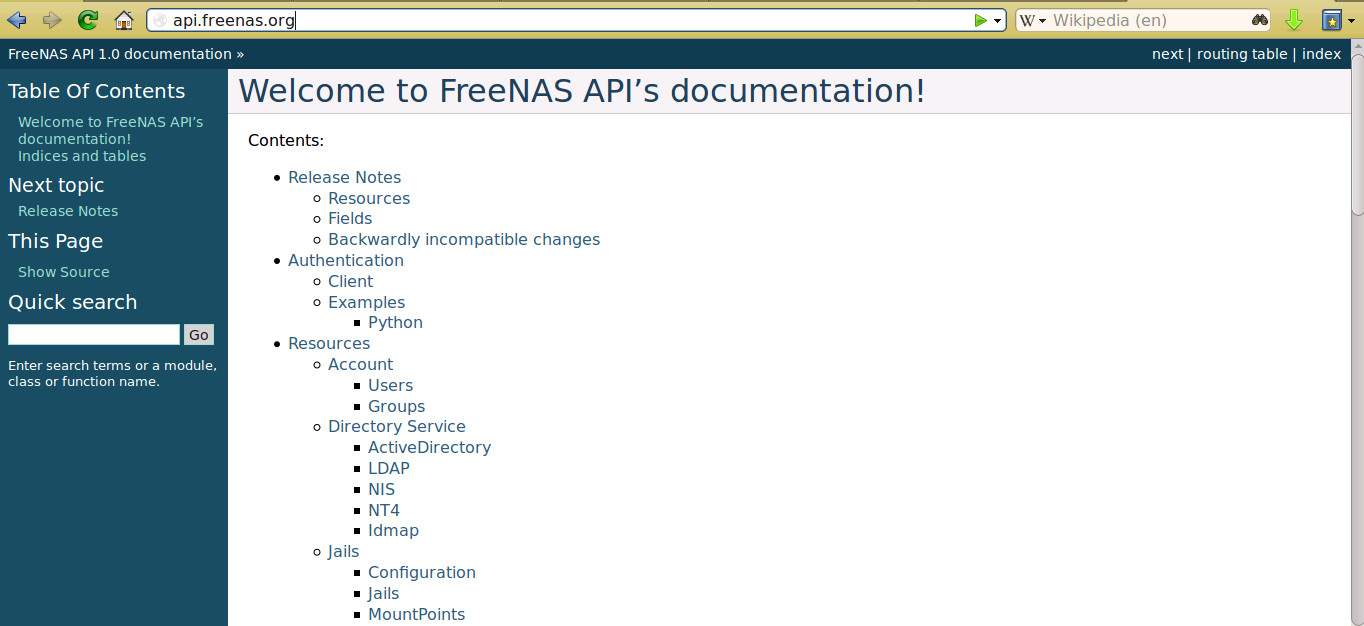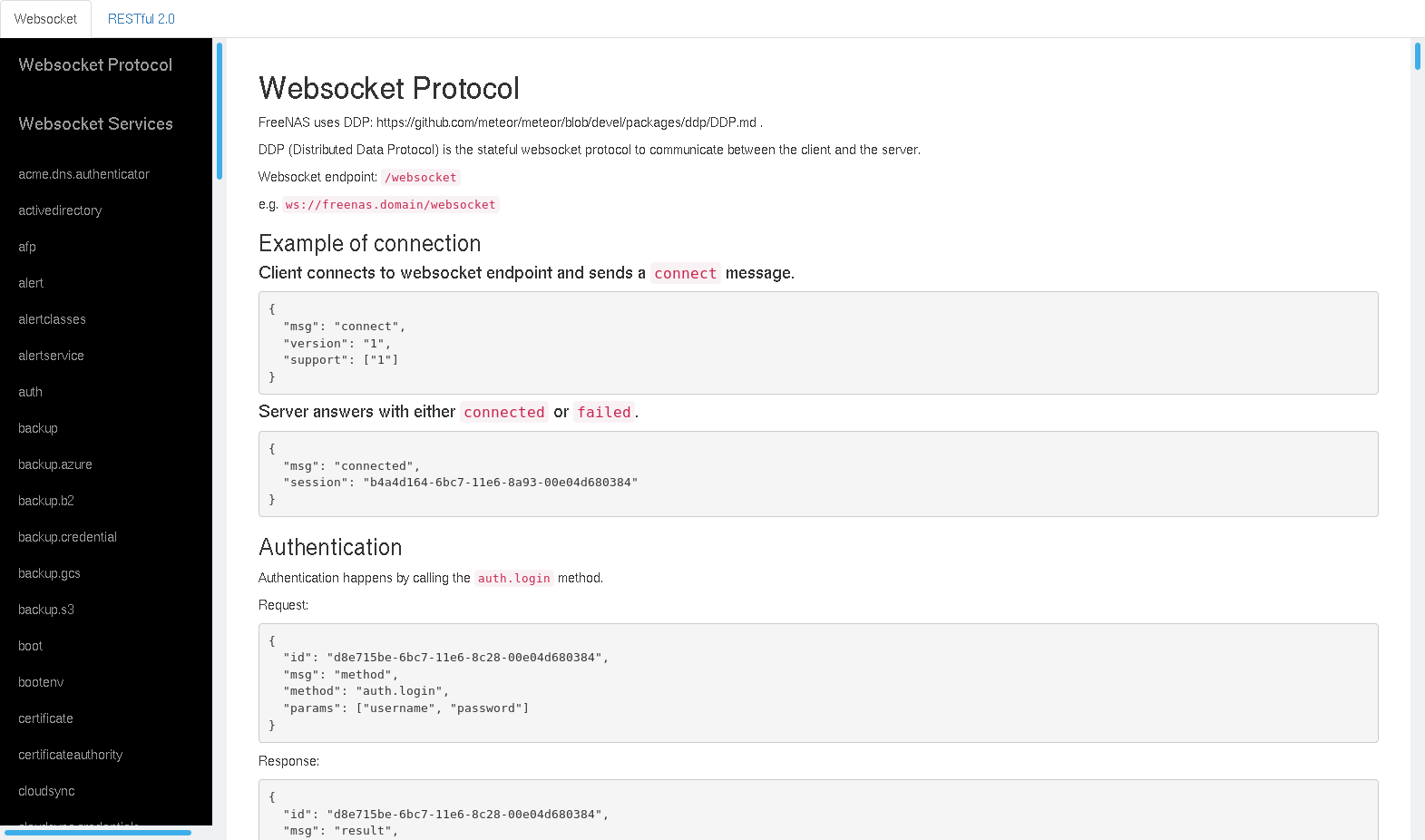17. Using the API¶
A REST API is provided to be used as an alternate mechanism for remotely controlling a TrueNAS® system.
REST provides an easy-to-read, HTTP implementation of functions, known as resources, which are available beneath a specified base URL. Each resource is manipulated using the HTTP methods defined in RFC 2616, such as GET, PUT, POST, or DELETE.
As shown in Figure 17.1, an online version of the API is available at api.freenas.org.

Fig. 17.1 API Documentation
17.1. APIv2¶
A new API was released with TrueNAS® 11.1. The previous API is still present and in use because it is feature-complete. Documentation for the new API is available on the TrueNAS® system at the /api/docs/ URL. For example, if the TrueNAS® system is at IP address 192.168.1.119, enter http://192.168.1.119/api/docs/ in a browser to see the API documentation. Work is under way to make the new API feature-complete. The new APIv2 uses WebSockets.

Fig. 17.1.1 APIv2 Documentation
This advanced technology makes it possible to open interactive communication sessions between web browsers and servers, allowing event-driven responses without the need to poll the server for a reply. When APIv2 is feature complete, the TrueNAS® documentation will include relevant examples that make use of the new API.
17.2. A Simple API Example¶
The api directory of the FreeNAS® github repository
contains some API usage examples. This section provides a walk-through
of the newuser.py script, shown below, as it provides a simple
example that creates a user.
A TrueNAS® system running at least version 9.2.0 is required when creating a customized script based on this example. To test the scripts directly on the TrueNAS® system, create a user account and select an existing volume or dataset for the user’s Home Directory. After creating the user, start the SSH service using . That user will now be able to ssh to the IP address of the TrueNAS® system to create and run scripts. Alternately, scripts can be tested on any system with the required software installed as shown in the previous section.
To customize this script, copy the contents of this example into a
filename that ends in .py. The text that is highlighted in red
below can be modified in the new version to match the needs of
the user being created. The text in black should not be changed.
After saving changes, run the script by typing
python scriptname.py. If all goes well, the new user
account will appear in
in the TrueNAS® GUI.
Here is the example script with an explanation of the line numbers below it.
1 2 3 4 5 6 7 8 9 10 11 12 13 14 15 16 17 18 19 | import json
import requests
r = requests.post(
'https://freenas.mydomain/api/v1.0/account/users/',
auth=('root', 'freenas'),
headers={'Content-Type': 'application/json'},
verify=False,
data=json.dumps({
'bsdusr_uid': '1100',
'bsdusr_username': 'myuser',
'bsdusr_mode': '755',
'bsdusr_creategroup': 'True',
'bsdusr_password': '12345',
'bsdusr_shell': '/usr/local/bin/bash',
'bsdusr_full_name': 'Full Name',
'bsdusr_email': 'name@provider.com',
})
)
print r.text
|
Where:
Lines 1-2: import the Python modules used to make HTTP requests and handle data in JSON format.
Line 4: replace freenas.mydomain with the Hostname value in . Note that the script will fail if the machine running it is not able to resolve that hostname. Change https to http to use HTTP rather than HTTPS to access the TrueNAS® system.
Line 5: replace freenas with the password used to access the TrueNAS® system.
Line 7: if you are using HTTPS and want to force validation of the SSL certificate, change False to True.
Lines 8-16: set the values for the user being created. The Users resource describes this in more detail. Allowed parameters are listed in the JSON Parameters section of that resource. Since this resource creates a FreeBSD user, the values entered must be valid for a FreeBSD user account.
Table 17.2.1 summarizes acceptable values. This resource uses JSON, so the boolean values are True or False.
| JSON Parameter | Type | Description |
|---|---|---|
| bsdusr_username | string | Enter a maximum of 32 characters. A maximum of 8 is recommended for interoperability. The username can include numerals but cannot include a space. |
| bsdusr_full_name | string | This field can contain spaces and uppercase characters. |
| bsdusr_password | string | The password can include a mix of upper and lowercase letters, characters, and numbers. |
| bsdusr_uid | integer | By convention, user accounts have an ID greater than 1000 with a maximum allowable value of 65,535. |
| bsdusr_group | integer | Specify the numeric ID of the group to create if bsdusr_creategroup is set to False. |
| bsdusr_creategroup | boolean | Set to True to create a primary group with the same numeric ID as bsdusr_uid. |
| bsdusr_mode | string | Sets default numeric UNIX permissions for the home directory of the user. |
| bsdusr_shell | string | Specify the full path to a UNIX shell that is installed on the system. |
| bsdusr_password_disabled | boolean | The user is not allowed to log in when set to True. |
| bsdusr_locked | boolean | The user is not allowed to log in when set to True. |
| bsdusr_sudo | boolean | sudo is enabled for the user when set to True. |
| bsdusr_sshpubkey | string | Enter the contents of the SSH authorized keys file. |
Note
When using boolean values, JSON returns raw lowercase values but Python uses uppercase values. So use True or False in Python scripts even though the example JSON responses in the API documentation are displayed as true or false.
17.3. A More Complex Example¶
This section provides a walk-through of a more complex example found
in the startup.py script. Use the searchbar within the API
documentation to quickly locate the JSON parameters used here. This
example defines a class and several methods to create a ZFS volume,
create a ZFS dataset, share the dataset over CIFS, and enable the CIFS
service. Responses from some methods are used as parameters in other
methods. In addition to the import lines seen in the previous
example, two additional Python modules are imported to provide parsing
functions for command line arguments:
import argparse
import sys
It then creates a Startup class which is started with the hostname, username, and password provided by the user via the command line:
1 2 3 4 5 6 7 8 9 10 11 12 13 14 15 16 17 18 19 20 21 22 | class Startup(object):
def __init__(self, hostname, user, secret):
self._hostname = hostname
self._user = user
self._secret = secret
self._ep = 'http://%s/api/v1.0' % hostname
def request(self, resource, method='GET', data=None):
if data is None:
data = ''
r = requests.request(
method,
'%s/%s/' % (self._ep, resource),
data=json.dumps(data),
headers={'Content-Type': "application/json"},
auth=(self._user, self._secret),
)
if r.ok:
try:
return r.json()
except:
return r.text
raise ValueError(r)
|
A get_disks method is defined to get all the disks in the system as a disk_name response. The create_pool method uses this information to create a ZFS pool named tank which is created as a stripe. The volume_name and layout JSON parameters are described in the “Storage Volume” resource of the API documentation.:
1 2 3 4 5 6 7 8 9 10 11 12 | def _get_disks(self):
disks = self.request('storage/disk')
return [disk['disk_name'] for disk in disks]
def create_pool(self):
disks = self._get_disks()
self.request('storage/volume', method='POST', data={
'volume_name': 'tank',
'layout': [
{'vdevtype': 'stripe', 'disks': disks},
],
})
|
The create_dataset method is defined which creates a dataset named
MyShare:
1 2 3 4 | def create_dataset(self):
self.request('storage/volume/tank/datasets', method='POST', data={
'name': 'MyShare',
})
|
The create_cifs_share method is used to share
/mnt/tank/MyShare with guest-only access enabled. The
cifs_name, cifs_path, cifs_guestonly JSON parameters, as well as
the other allowable parameters, are described in the “Sharing CIFS”
resource of the API documentation.:
1 2 3 4 5 6 | def create_cifs_share(self):
self.request('sharing/cifs', method='POST', data={
'cifs_name': 'My Test Share',
'cifs_path': '/mnt/tank/MyShare',
'cifs_guestonly': True
})
|
Finally, the service_start method enables the CIFS service. The srv_enable JSON parameter is described in the Services resource.
1 2 3 4 5 | def service_start(self, name):
self.request('services/services/%s' % name, method='PUT', data={
'srv_enable': True,
})
|